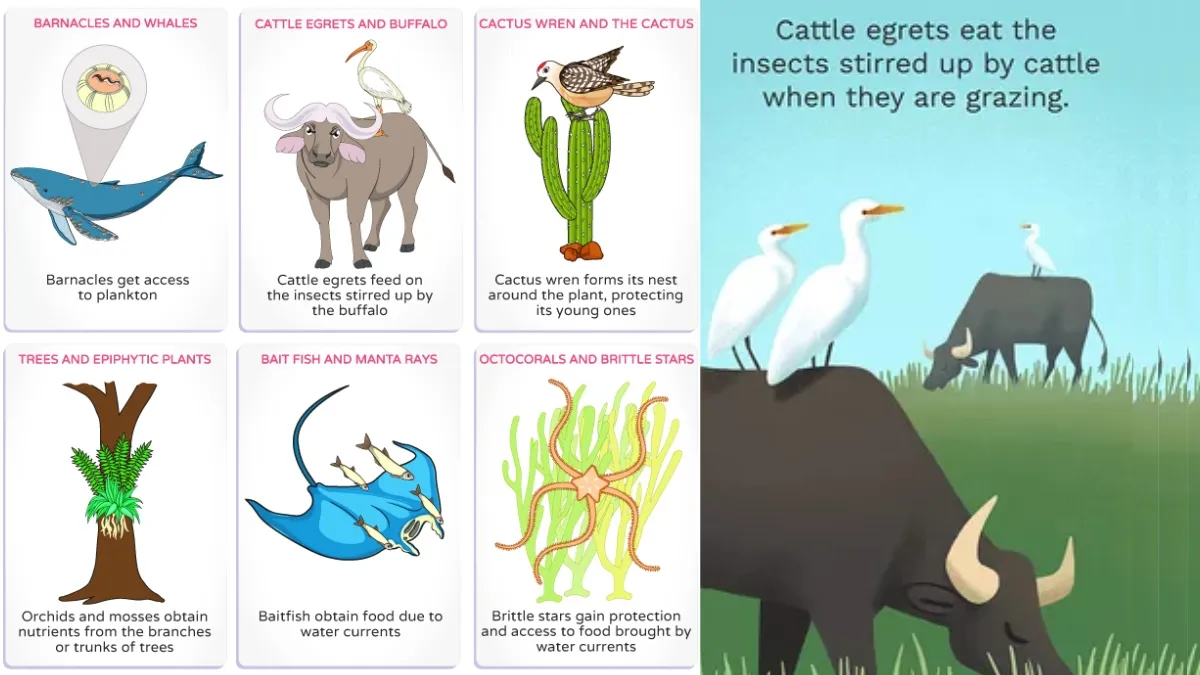Commensalism: Commensalism is a type of relationship between two organisms in which one organism is beneficial to the other without harming the other. It is like a coexistence – one species finds shelter, food, or support, while the other remains unaffected without harming the other. In Commensalism relationships, one organism that is getting all the support and benefits is commonly referred to as “commensal”, and the other organism that is supporting without causing any harm to the other organism is called “host”. Usually, the commercials are smaller in size and may develop unique features that help them to adapt to this lifestyle. In this article, we will understand what commensalism is and its types with examples.
Source: thoughtco
What Is Commensalism?
The term “commensalism” was first used in 1876 by Belgian palaeontologist and zoologist Pierre-Joseph van Beneden. Commensalism is a symbiotic relationship between two organisms in which one is getting benefits and support, which is called the commensal, and the other organism, which is giving support and benefits to the other, is called the “host”. Commensalism is just unconditionally derived for shelter, food and transportation from the host. Apart from this, this is a single and one-way relationship, but it maintains the ecological balance between the different organisms.
For example, the remora fish, which latches onto sharks or large fish and survives by eating scraps or waste without affecting the host. Similarly, pilot fish swim alongside bigger predators, feeding on leftover bits from their meals. In another case, some birds perch on large grazing animals like cattle and take advantage of insects that are stirred up from the ground as the animals move.
How many types of commensalism are there?
There are four types of commensalism; they are:
1. Phoresy
One organism uses another purely for transport.
Example: Remora fish attaching to a shark for a free ride and food scraps.
2. Inquilinism
One species lives inside or on another, gaining shelter.
Example: Hermit crabs occupy empty snail shells for protection.
3. Metabiosis
One organism makes the environment suitable for another, often unintentionally.
Example: Dung beetles feed on animal faeces, creating a micro-ecosystem for microbes.
4. Microbiota Association
Microorganisms live in or on larger organisms without harming them.
Example: Skin bacteria living on humans; they help by outcompeting harmful microbes, but don’t impact us negatively.
Source: sciencenotes
What are the real-life examples of Commensalism?
Now let's see the real-life examples of Commensalism:
-
Sharks and Remoras: Remoras benefit by feeding on leftovers and getting transportation, while the shark remains unaffected.
-
Cattle Egrets and Grazing Animals: Egrets follow cows and feed on insects stirred up by their movement.
-
Barnacles and Whales: Barnacles stick to whales to filter food from moving water.
-
Hermit Crabs and Empty Shells: They use abandoned shells for safety.
-
Orchids and Tree Branches: Orchids grow on trees to reach sunlight, but don’t steal nutrients from the tree.
Commensalism in Plants
In the plant world, commensalism is surprisingly common:
-
Epiphytes (like orchids or ferns) grow on trees to get better sunlight and air exposure without harming the host.
-
Vines sometimes use tall trees to climb upward for sunlight, but don't feed off the tree.
-
Seed Dispersal by Animals: Some plants have burrs that stick to animal fur, hitching a ride to new areas—without affecting the animals.
Sometimes, these relationships can shift. For instance, an epiphyte may later compete with its host for water, blurring the lines between commensalism and parasitism.
Commensalism in Microbiology
Commensalism is also key in the microbial world:
-
Skin Flora: Harmless bacteria live on human skin, preventing harmful microbes from taking over.
-
Gut Microbes: Some gut bacteria thrive by feeding on undigested food, helping us indirectly with digestion and immune defence.
-
E. coli (non-pathogenic strains): Many live peacefully in our intestines and help balance harmful microbes.
However, changes like antibiotic use can upset this balance (known as dysbiosis), which may lead to health problems like diarrhoea or inflammation.
Conclusion
Commensalism is one of nature’s quieter partnerships—where one organism gains benefits like food, shelter, or transport, while the other goes about its life, unaffected. From remoras hitching rides on sharks to orchids growing on tree branches, these interactions may seem simple, but they play an essential role in maintaining balance in ecosystems. Whether in plants, animals, or even microscopic life inside our bodies, commensalism helps species adapt and survive without creating conflict. Understanding these relationships reminds us just how interconnected all living things truly are.

Comments
All Comments (0)
Join the conversation